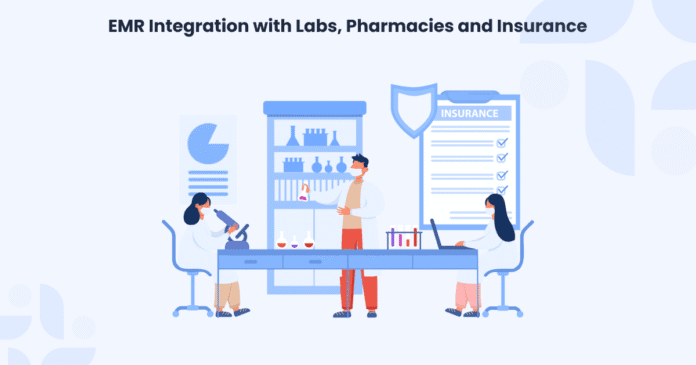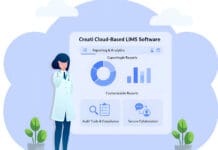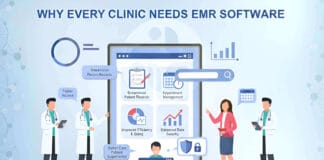
Healthcare is changing fast. Doctors and clinics in India are moving away from paper records and adopting EMR for healthcare providers in India to manage patient information. But just having an EMR isn’t enough. Its real power comes from how EMR connects with labs, pharmacies, and insurance, creating a seamless workflow for better care.
When these systems work together, patients get faster care, doctors spend less time on paperwork, and clinics benefit from the EMR integration. Integration makes healthcare simpler, safer, and more organized for everyone.
Why Integration is Important
Picture a clinic where lab results, prescriptions, and insurance claims are all handled separately. Doctors wait for lab reports, staff spend hours on the phone with pharmacies, and patients face slow insurance approvals.
Integration completely changes this. When Healcard EMR connects with labs, pharmacies, and insurance systems:
- Doctors can see all patient information in one place.
- Mistakes from manual entry are minimized.
- Patients receive care faster and more smoothly.
- Clinics save time and resources.
Integration isn’t just about making things easier; EMR integration improves patient care and helps clinics operate more efficiently.
How EMR Integration Works with Labs
Laboratories are an essential part of healthcare. Every test, from blood work to imaging, gives doctors critical information for diagnosis and treatment. When Healcard EMR is integrated with labs:
- Test orders are sent directly from the EMR to the lab.
- Results automatically return to the patient’s record.
- Doctors can view results quickly and make decisions without waiting for paperwork.
This EMR integration with labs reduces errors, saves time, and keeps patient records accurate and complete. It also helps clinics manage tests more efficiently, track pending results, and prevent delays.
How EMR Integration Works with Pharmacies
Medication management is another critical part of patient care. With Healcard EMR connected to pharmacies:
- Prescriptions are sent electronically, eliminating handwritten errors.
- Doctors can see whether a patient has filled a prescription or is taking other medications.
- Clinics can check medication availability and adjust treatment plans accordingly.
EMR integration with pharmacies makes prescribing safer, reduces mistakes, and ensures patients get the right medicine at the right time. It also saves staff from repetitive calls and follow-ups with pharmacies.
How EMR Integration Works with Insurance Providers
Insurance is often one of the trickiest areas in healthcare. Patients and clinics deal with delays, rejections, and endless paperwork. Healcard EMR integration with insurance makes the process simpler:
- Eligibility checks happen instantly.
- Claims are submitted directly through the EMR.
- Approvals and reimbursements come faster and with fewer errors.
This not only eases stress for patients but also shows the benefits of EMR integration with insurance for clinics, helping manage cash flow and improving efficiency. Doctors and staff spend less time chasing approvals and more time caring for patients.
The Combined Benefits of Full Integration
When labs, pharmacies, and insurance are all linked to Healcard EMR, everything runs more smoothly. Doctors get the information they need right away, staff spend less time on admin, and patients experience faster, safer, and more reliable care, highlighting the benefits of EMR integration with labs, pharmacies, and insurance
This kind of connected system builds trust between patients and providers, cuts down on mistakes, and lets clinics concentrate on delivering quality healthcare rather than wrestling with disconnected systems.
Challenges to Integration
Bringing everything together isn’t always simple. Some of the common challenges are:
- Keeping patient information safe: Privacy and security have to be protected at all times.
- Different systems not matching up: Labs, pharmacies, and insurance companies don’t always use the same technology, which makes connecting them tricky.
- Training staff: Everyone needs to learn how to use the system the right way, how to place test orders, check results, and update records.
Even with these challenges, the advantages are much bigger. With the right EMR system and good support, clinics can handle these issues and make their work much smoother.
Tips for Choosing an Integrated EMR
Not every EMR offers the same level of integration. Here are some simple tips to keep in mind when choosing one for your clinic:
- Check if it integrates with the local labs and pharmacies you already work with.
- Look for built-in insurance claim support.
- Ask about compliance with healthcare standards (like ABDM in India internationally).
- Make sure it has good training and support for your staff.
- Always ask for a demo to see how smooth the workflow really is.
Choosing the right clinic management software or digital health solution, like Healcard EMR, saves clinics time and frustration while offering all the EMR integration benefits for clinics.
The Future of Integrated EMRs
Healthcare technology is evolving, and EMRs are becoming even smarter. In the future:
- AI and data analytics will help doctors make better decisions using information from labs, pharmacies, and insurance.
- Patients may have full access to their health records, making them more involved in their own care.
- Digital health initiatives are pushing for nationwide standards, ensuring that patient data can be shared safely and securely across systems.
EMR for healthcare institutions is evolving, and integrated EMRs are not just a tool for today; they form the foundation for the future of healthcare.
FAQs About EMR Integration
Here are some common questions clinics usually ask:
Yes, modern digital health solutions and EMR for healthcare providers in India follow strict security standards.
Not all, but most modern ones do. It’s always good to check with your EMR provider about compatibility.
It depends on the size of the clinic, but with good support, most can be set up within a few days to weeks.
Integrated EMRs usually save money in the long run by reducing errors, saving staff time, and speeding up reimbursements.
Yes, most integrated EMRs now come with patient portals or mobile apps. Patients can view lab results, prescriptions, and even track insurance claims directly, which makes them more engaged in their own care.
Absolutely. Patients get quicker lab results, fewer prescription errors, and faster insurance approvals thanks to EMR integration with labs, pharmacies, and insurance.
Conclusion
Healthcare works best when everything is connected. An EMR on its own is helpful, but when it integrates with labs, pharmacies, and insurance, it becomes a complete solution. Patients move through their care without delays, doctors have all the information they need, and clinics save time and resources.
The challenges of integration are real, but they’re short-term. The benefits of safer care, smoother workflows, and stronger patient trust last for the long run. Choosing the right EMR means choosing a partner in that journey.
If you want your clinic to work smarter, save time, and give patients the best care possible, consider an integrated EMR like Healcard.
Need help? Contact us at support@healcard.com




